THE EPICA AWARDS TRIBUNE
THE GLOBAL CREATIVE PRIZE JUDGED BY JOURNALISTS, NOT CREATIVES
Instead of provoking shivers, a spider captured the hearts of viewers (and awards judges). Benjamin Merkel, ECD of Leo Burnett Germany, tells us how the creative team wove their web.
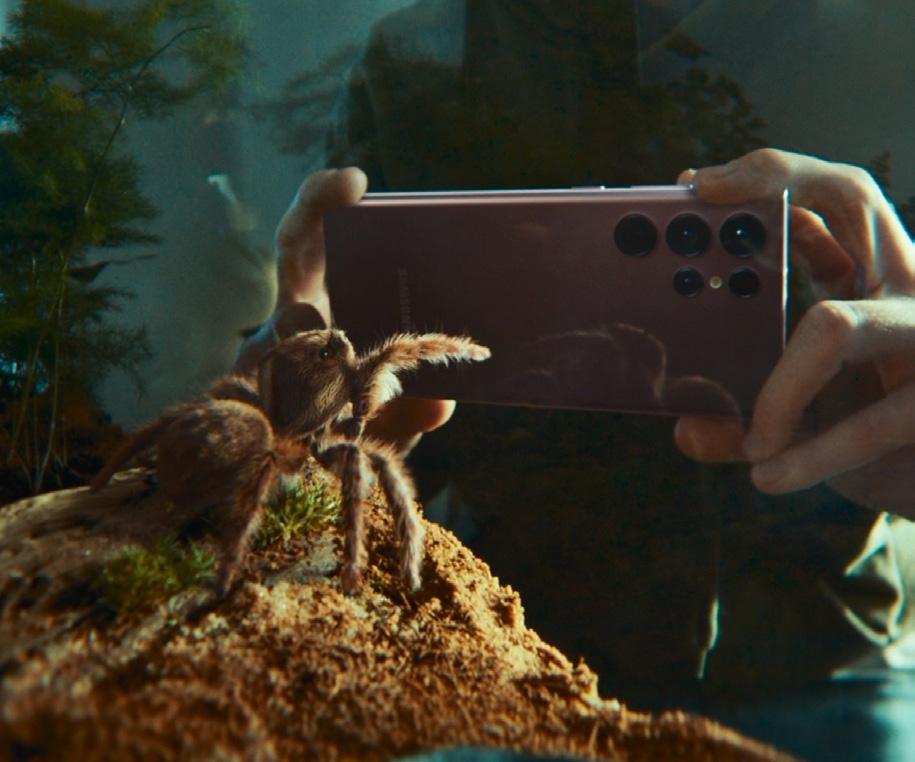
HOW a ukrainian agency WINS AWARDS AND CLIENTS IN THE MIDST OF WAR

Independent agency Bickerstaff.655 sends us an update and reflects on a patriotic packaging campaign.
Camera lenses often capture emotions, but they rarely inspire affection. Until one day, along came a spider… Leo Burnett Germany’s film for the Samsung Galaxy S22 Ultra squeezes warmth and humanity from an insect and a mobile phone, a feat that makes it a deserving award-winner. But how do you get from a brief about a new phone to an amorous arachnid?
Benjamin Merkel, executive creative director of Leo Burnett Germany, says: “The client didn’t give us a very detailed brief – just to focus on the camera and its features, which is always the case with the S series. They added that we could talk about the camera design.”
The “design” was essentially a cluster of lenses. Powerful –and useful – but not obviously beautiful. “As we talked about it we realised the lenses looked like the eyes of an animal, or an insect. Maybe a fly, but more like a spider.”
The result was a script with just two or three lines: a spider
Continued on page 2
GEO FOCUS
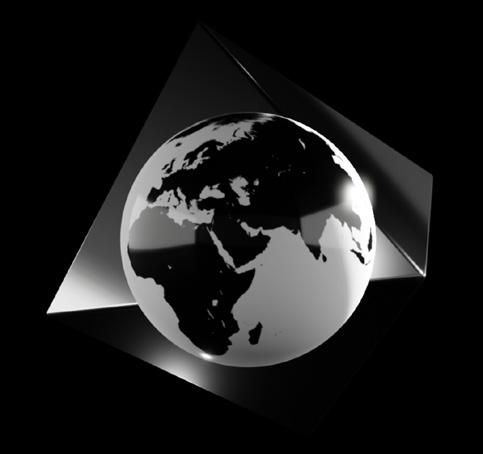
Who ranked at the top of your region last season? The answer on page 8
Ukrainian agency Bickerstaff.658 (the number frequently changes – see below) won a Gold in the Non-Alcoholic Drinks category at the Epica Awards, despite being based in war-torn Kyiv. Launched at the beginning of the conflict, the packaging-driven project involved replacing the name of a well-known dairy brand with the names of 14 different Ukrainian regions. A year later, we find out how the agency is bearing up.
What is your current situation – where are you and your colleagues working now?
We have a hybrid work format. Part of the team is abroad, but the majority is in Kyiv, and we continue to work there despite the blackouts and everything else. We ordered a Starlink [satellite internet service], equipped the premises with generators…For us it’s a war, but for our customers the business must keep moving despite external circumstances. We even stipulate in contracts that the war is not a force majeure, and that we fulfil all obligations. So we allocate resources to each project to ensure that we can always function smoothly.
How are you managing to work and communicate day-today, amidst the attacks and power outages?
After October 10, rolling and then emergency blackouts began in the country. At the beginning of the full-scale war, we abandoned the office. This decision was made to save the team and salaries. But now, due to the blackouts, the question of how and where to work has become more urgent. That’s why we are returning to the office. We are currently preparing a place
where we will have all the necessary equipment: generators, Starlink and a safe shelter.
Have you managed to keep all your clients during this period? Or indeed, have new ones come aboard?
We have always paid attention to the social component of projects, but since the outbreak of war, a large share of our work has been exclusively volunteer projects. For the agency, these are important as our contribution to victory. Now the situation has balanced out, we have opened an office in Lisbon and resumed more stable work in Kyiv. We have clients from the UK – one of these projects is the branding of the Duke of Edinburgh’s “Stand by Me” Award –Germany, Poland, the United States, and of course we continue to do a lot of projects for Ukraine.
Let’s talk about your Gold-winning campaign, “We Instead of Me”. How did the idea for the campaign emerge? Were you already working for the brand Galychyna?
The client came to us with the task of creating a brand communication that would be relevant “during the war and even after”. The first thing we did was pour ourselves a full glass of Galychyna, drink it, get inspired by our milk moustaches, and start thinking about how Ukraine and its people have changed. And we realized that our unity is our strength, and that we are inspiring not only ourselves but people around the world. That’s how the “We Instead of Me” strategy was born – and the
Continued on page 2
2022 FILM GRAND PRIX Romancing the phone
v “Now, due to the blackouts, the question of how and where to work has become more urgent.”
THE EPICA AWARDS TRIBUNE
THE CREATIVE PRIZE JUDGED BY JOURNALISTS
Continued from page 1
looks out of the window, sees an image of the phone on a billboard, and falls in love. “I think the real magic of the idea is its simplicity,” says Benjamin. “To that first magic moment we added a second one, when the billboard is removed and, of course, love hurts.”
A simple idea that nonetheless required a lot of craft. To shoot the film, the agency chose young directing duo Dorian and Daniel. The pair graduated from Germany’s best film school, Filmakademie Baden-Württemberg in Stuttgart, where they’d attracted attention with a spec film for Johnnie Walker called “Dear Brother”. They were also included in the 2017 Saatchi & Saatchi New Directors’ Showcase, setting them on an award-winning career path.
“We felt they were a good fit for us because we wanted a diffe-
which enriched the original simple story.”
Post-production was by The Mill. While Samsung Germany was behind the idea the whole way, there was a lot of debate about the character design of the spider. After all, some people are genuinely afraid of the insects. “We felt that it shouldn’t be too realistic – but not too cartoon-like either,” says Benjamin.

“In the end we have something in between, with little details that give her emotion, like the way her antenna droop when the billboard disappears, and even the little tears of sadness in her eyes.”
The agency got the original brief at the end of March 2021, with the script emerging only a week later. But the lengthy process of bringing the idea to life meant that the agency missed the launch of the phone it was originally destined for: the S21. Fortunately, Samsung loved the story and decided the film could be used for the S22 instead.
“There was some anxiety because we didn’t know what the new phone would look like – what if it had completely different lenses? Then our story would be dead! We shot the whole film anyway and started work on the character design, and luckily when the phone was released the lenses looked the same, even if some of the features were more advanced.”
Day?’ As a result, we started working on a successor.” A third film may appear on Valentine’s Day 2024, too. If all goes according to plan, Samsung phones will be associated not just with sleek design and great cameras, but with romance too.
rent atmosphere from the usual cool and crisp Samsung film – a bit more moody, with a sort of David Fincher feel about it. Soon it was clear that we’d made the right choice, because they added a lot of scenes, like the spider swinging in the water jug,
Continued from page 1
idea along with it.
Ukrainian brands that were competing for customers yesterday have united to ensure that all their customers can return to their families. Since the early days of the war, Galychyna has been doing everything possible to support the country: donating products to charity and sending them wherever possible – and sometimes impossible!
The company’s new communication is primarily about “we”. After all, in the first hours of a full-scale war, Ukrainians organized themselves to fight against a common enemy. Ukrainians win together, no matter what region they come from.
Everyone here knows the Galychyna brand is named after one of Ukraine’s historical regions. So we decided to talk not just about Galychyna, but other regions too.
How did you arrange the logistics of the campaign, which required redesigning the bottles to include 14 different names?
The logistics were complicated as some of the materials were printed in a region where there are very active hostilities. The whole campaign came with a lot of risks. As a result, in some regions the campaign actually started before the “official” launch – when people saw the packaging on the shelves – while in other regions people asked whether it was fake and when they could buy the bottles.
How did the client distribute the bottles to the corresponding regions, as I imagine that transport was disrupted? How many bottles were there?
We have been delivering our products all over the country, except for the occupied territories and the front line, where heavy fighting is taking place. Of course, there were (and are) some difficulties, but we are solving them. More than six million bottles were sold as part of the “We Instead of Me” campaign.

What were the reactions on social media?
The film was launched on Valentine’s Day. “It wasn’t originally planned that way, but since the film took us a long time to create, we decided to schedule it for that day. It worked so well that we were able to say to the client: ‘A lot of agencies own Christmas with their films – so why don’t we own Valentine’s
Ukrainians appreciated the idea and began to actively share photos, their emotions and impressions on Twitter. People wrote that this was the first milk that made them cry. The first results were felt when people started posting poems and photos of Galychyna, Donbass or Slobozhanshchyna. The idea resonated as soon as people saw the packaging on the shelves. The communication began to promote itself, as evidenced by numerous TikToks, memes and other content.

What was the most surprising thing about the campaign?
The media result can be summed up by the phrase “the first milk in the world that moved me”. Not because of our idea, but because of people’s words. A thing as ordinary as a bottle of milk strengthened people’s love for their native home. We received more than 20 million digital media impressions in the first month of the campaign alone. People dedicated songs to
milk, created memes, recorded duets in TikTok, took selfies with bottles of milk… On Ukrainian Twitter, “Galychyna” has almost become a leading topic. People share information about their regions and post their own memories.
v “People wrote that this was the first milk that made them cry.”
Finally, why do the numbers at the end of your name change all the time?
The thing with the numbers is just our feature, which we love very much and find it funny. If you want to, you can use Bickerstaff.655 everywhere to make it clearer.
Answers by Olya Gonchar, PR Manager, Bickerstaff.655
PAGE NUMBER 2 2022- 2023 EDITION
Benjamin Merkel, ECD at Leo Burnett Germany
“I think the real magic of the idea is its simplicity,”
THE EPICA AWARDS TRIBUNE
A masterwork of inclusive design
The industrial designer Marc Harrison believed that if you created products that solved problems for people with disabilities, they became better for everyone. His philosophy of “universal design” led to the 1979 Cuisinart food processor – among other things – a beautiful object with big bold buttons.
The “Touch Card” from Mastercard and McCann New York works the same way. The distinct notches in the side of the card allow blind and visually impaired people to tell their credit, debit and prepaid cards apart, by touch alone. An idea of simple genius that comes in handy for us all. Of course, Mastercard and McCann New York have previous when it comes to innovation. Is there anyone who hasn’t praised the “True Name” initiative? As you’ll recall, it allowed Trans and Nonbinary people to display their chosen names – rather than their birth names –on their credit cards, resolving a potential source of pain and humiliation.

McCann New York’s chief creative officer Pierre Lipton reiterates that “True Name” was triggered by the personal experience of a creative at the agency.

The transgender man had popped out to the deli to pick up his lunch, only to find that the orders were being called out using the first names on credit cards.
As the name on his card was a woman’s, he suddenly panicked and asked a female colleague to pick up his order. “He later came to us and said, ‘Here’s a problem that I’m experiencing – what can we do about it?’”
This was the beginning of the journey that led to “True Name” – but it would never have happened if the client hadn’t championed the idea. Pierre emphasises that Mastercard has long been a purpose-driven company: one of its mantras is “Doing well by doing good.” In other words, there’s a business advantage to improving customers’ lives.
Nonetheless, he says, “True Name” was an inflection point in the way the agency works with Mastercard. “Part of that is what I call ‘barrier hunting.’ When you’re working with a client, you should always look for the barriers consumers face with the product or service. Because where those problems are, opportunities follow.”
Simple yet complex
“Touch Card” came about when Mastercard identified a problem facing part of its customer base. With cards now flat, blind and visually impaired people could no longer tell their cards apart by running their fingertips over the raised digits. So the company began liaising with the RNIB (Royal National Institute for the Blind) in the UK, as well as VISIONS and IDEMIA, to find a solution.
While Braille might spring to mind, Pierre points out that less than 10 percent of the blind and visually impaired population in the US can read it. The tactile notches – rounded for debit, squared for credit and triangular for prepaid – are universally practical.
Pierre mentions that the RNIB also spoke about inclusivity by
design – solving a problem for one group to make life better for many. “It’s not easy for any of us to pick the right card immediately, especially in an environment where the lighting is bad.
And keep in mind that the notches also tell you which way to put the card into an ATM machine.”
As the innovation would be rolled out globally, the design had to be compatible with machines all over the world. And the notches had to be placed where they wouldn’t interfere with the card’s circuitry. “Creating the notches was more complex than it might seem.”
was happening on the screen.”
For example, Joel drew attention to the word “walks” in the script. In fact, the listener wants to know how the person walked. Did they march? Did they stroll? Did they saunter? The idea is to paint a picture in the listener’s mind. “The back and forth with Joel on the script was a rich process.”
In addition, a radio spot used 3D directional sound to recreate the way blind or partially sighted people experience shopping. To help, one of the agency’s visually impaired advisors, Bree Klauser, showed the team how she navigates while grocery shopping. Pierre says: “She told us things like, ‘I know when I’m approaching the vegetable aisle because I can hear the hum of the refrigeration over there…’ We would never have learned these things if we hadn’t admitted our own ignorance and actively listened to people who experience life differently.”
Another breakthrough was a hack by the agency that allowed audio screen readers to read a banner ad from Mastercard – a first, as ads are normally inaudible. To be precise, the reader didn’t read out the actual text: the audio message was encoded in the banner. “It’s a smaller element of the campaign, but one that I’m very proud of,” says Pierre.
A network of “makers”
A strategy based on listening
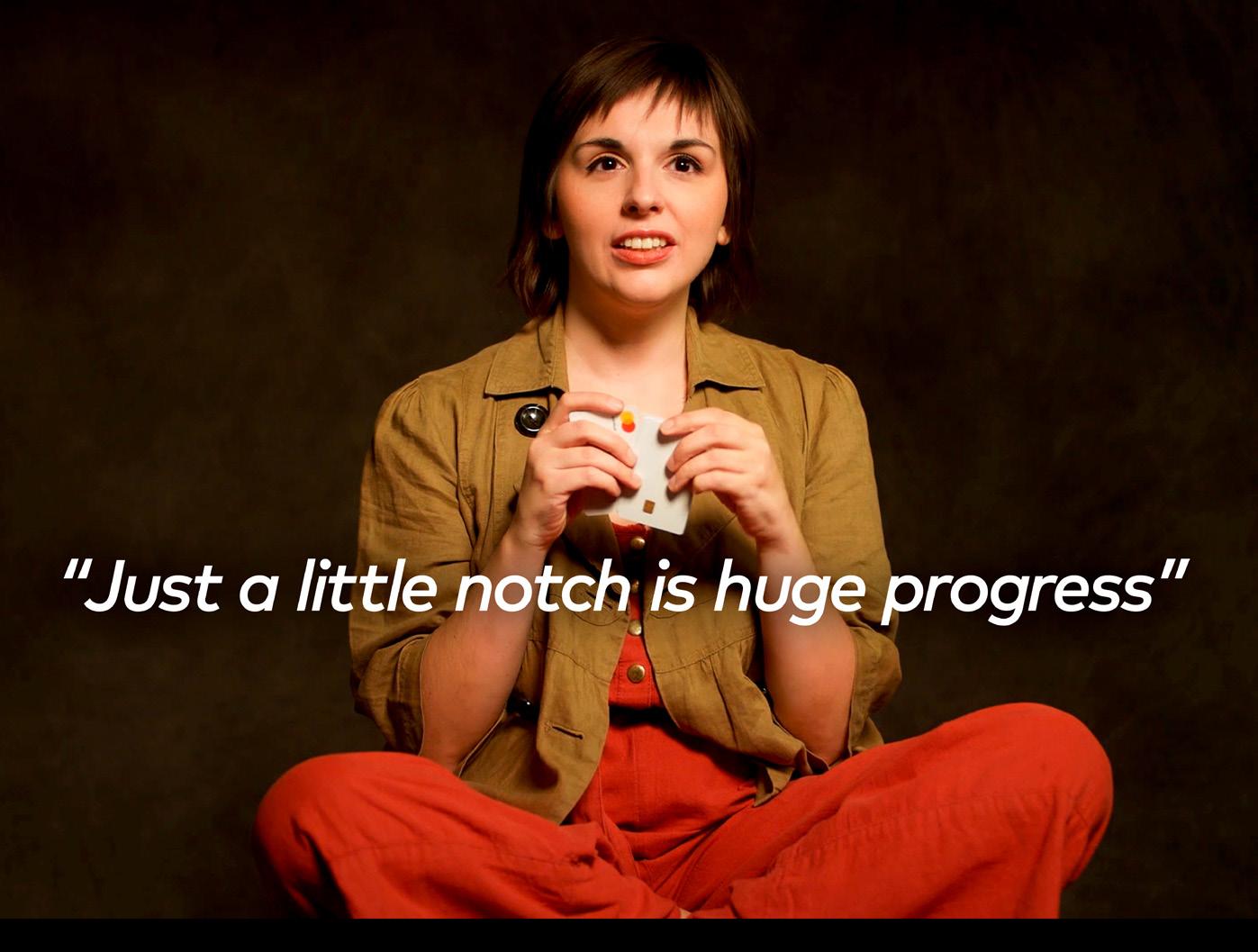
Having designed the card, Mastercard and McCann had to launch it. This required an audio solution. So the agency made a film – but with audio descriptions playing a central role in the story. As part of that process, McCann reached out to Joel Snyder, Ph.D, owner of Audio Description Associates and the
The “Touch Card” was the most successful of more than 20 prize-winning campaigns that led to McCann Worldgroup being named Network of the Year – for the fifth time. The network is well known for its ethos of “helping brands earn a meaningful role in people’s lives.” But Pierre also has some personal views about what makes the network shine. Ultimately, he feels that McCann’s real secret is its culture. “The way I’ve experienced McCann is that it’s a culture of ‘doing.’ My wife is a labor and delivery nurse, and I always say that McCann is a place where everybody puts their scrubs on. The people who do well here generally have a deep level of craft in their specialty – whether it’s creative, strategy or client services. When you have a group of people who’ve gone up the ladder by making things, that passion remains.”
It’s not a culture of egos. On his first week at McCann, Pierre was called in on a Sunday to write some scripts for Verizon. The CCO at the time joined him, more than willing to roll up his sleeves. “We value the idea – and we always work to grow and service the idea.”
audio description expert in the US.
Pierre says: “I’m a writer by trade – but working with Joel was a masterclass in writing audio descriptions that were the most crystallized way of giving the listener a clear indication of what
The constant hunt for barriers, teamed with a passion for finding the most creative ways of overcoming them, may be the perfect formula for supercharging brands.
PAGE NUMBER 3
2022- 2023 EDITION
THE CREATIVE PRIZE JUDGED BY JOURNALISTS
McCann New York’s chief creative officer Pierre Lipton describes how a willingness to listen and the power of words gave the “Touch Card” initiative a touch of
magic.
Pierre Lipton, Chief Creative Officer at McCann New York
The “Touch Card” was the most successful of more than 20 prize-winning campaigns that led to McCann Worldgroup being named Network of the Year
“When you have a group of people who’ve gone up the ladder by making things, that passion remains.”
2022 FILM GRAND PRIX & Mccann WOrldgroup Network of the year
BY JOURNALISTS
All aboard for a pirate football game
How the agency Mirum in Brazil created a hilarious fake football match with a serious goal.
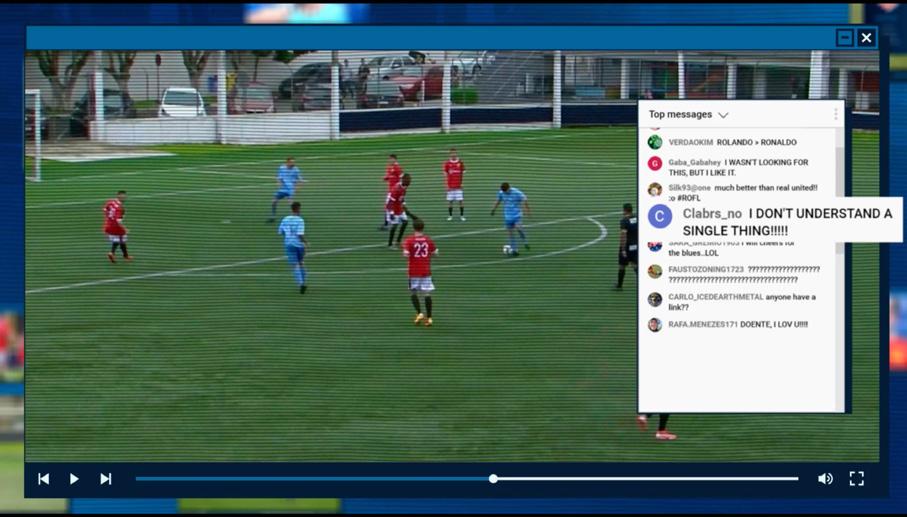

Once the fake match was ready, a strategy was needed to ensure viewers would find it. Amanda – who played the role of orchestra conductor to bring all the elements together – says: “While the creative and production part of the project was underway, our media and SEO teams were working behind the scenes figuring out how to use Google Ads and search terms to drive the audience to the match.”
At the same time they worked with the design team to create the landing page, which had to be tagged in Google. So the agency also liaised with Google to make sure they were aware of the project.
Research unearthed several terms viewers use to find illegally streamed matches, which were then bought by the agency. Filipe says: “They were quite unusual terms, specifically related to piracy, so they weren’t too expensive. We didn’t have a huge media budget, but in the end it worked out.”
And what about the reaction of viewers? Weren’t they annoyed to be hoodwinked?
“From set-top boxes to modified ‘fire sticks’, illegal streams of soccer matches are a headache that will not go away.”
I read that line in The New York Times in a café on a cold morning in January. It came in handy, because I was about to start writing this article – about Mirum’s “Pirate Match” campaign for DirectvGo, which aimed to tackle exactly that problem.
The agency’s idea is far easier to describe than it was to achieve. While searching for an illegal stream of a Champions League match, viewers stumbled across a game that looked kind of right…but also very wrong. In fact, all the players were impersonators, and the match was a well-orchestrated (and very funny) fake.
Initially, DirectvGo wanted to announce their sponsorship of one of the biggest teams in Brazil, Flamengo, for that season, as well as encouraging viewers to subscribe. When the creative team met, the idea of using impersonators emerged.
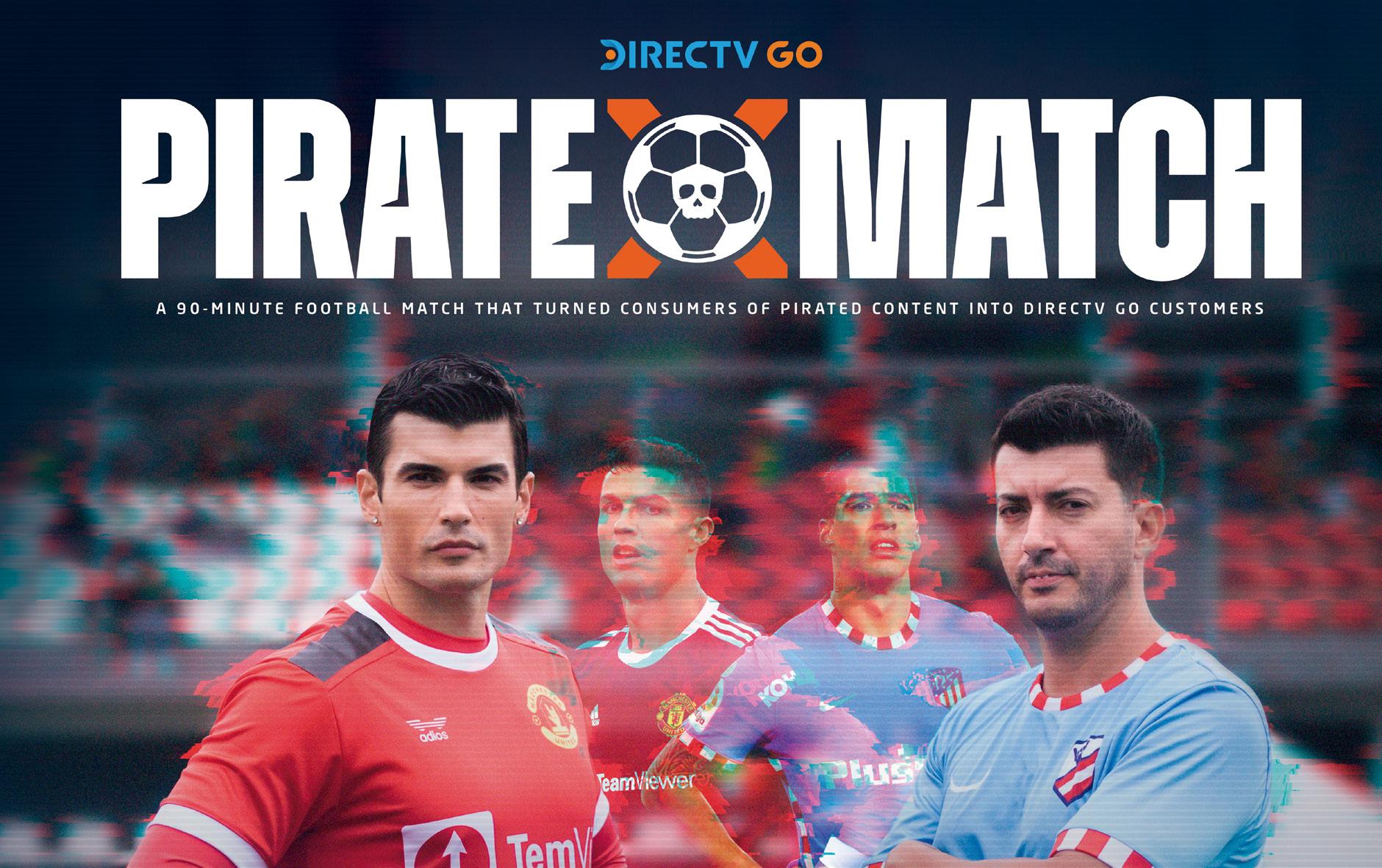
Creative director Filipe Matiazi says: “Football is very much loved in Brazil – and so are the players. So there are quite a few ‘doppelgangers’ of well-known players; and some of them are even famous in their own right. The team thought it would be funny to use them in some way.”
Although the idea didn’t quite fit the sponsorship brief, the pieces fell into place when the subject of piracy emerged as a major challenge for the client. “That’s when the idea came back onto the table and we began to develop it more seriously,” says Filipe.
“Football is very much loved in Brazil –and so are the players. So there are quite a few ‘doppelgangers’ of well-known players; and some of them are even famous in their own right. The team thought it would be funny to use them in some way.”
The project became supercharged when it was presented at the global WPP creative meeting – and was universally acclaimed, which meant the agency was greenlighted to invest in it as a potential award-winner, with support from the network. But then, of course, the “pirate match” had to be staged.
The Champions League was strategically chosen for its international status, later attracting the attention of the internatio -
nal press – notably Contagious, which featured the fake match as one of the year’s best ideas.
Agency producer Paulo Setti says: “There was a natural deadline, because we’d identified a particular Champions League match (Atlético Madrid vs. Manchester United), so we needed to have everything ready in just over two weeks. Not all the doppelgangers were here, so we had to import some of them.”

“Actually they loved it,” says Filipe. “As we said, Brazilians live and breathe football. But at the same time, we have a sense of humour about it. Of course, we used teams from other countries. Maybe if we’d used our own teams, we might have gotten a bit of a backlash. But since it was all gringos, the people thought it was great…And by the way, Brazilians love pranks!”
The guy who played Cristiano Ronaldo, for example, came from Serbia, but happened to be in Brazil visiting his wife’s family. “He’s a model, not a football player – as you can tell from the images. Which was great for us. The less well they played, the better.”
Originally the plan was to have only two or three truly convincing lookalikes per team, but on the day both sides had more than their fair share of doubles. The creative team also gave them funny names: for example “Felix”, which is close to “happy” in Portuguese became “Tristex”, resembling “triste”, or “sad”.
“A lot of them were actors or comedians who already knew one another,” says project manager Amanda de Oliviera, “so the atmosphere was really fun, even though it rained all day.” The fake match was recorded – not streamed live – because there was a certain amount of choreography involved. But in the end, little editing was required.
The match was also a challenge – and a triumph – for art director Daniel Mota. As the agency didn’t know who’d be playing in the final round of 16 until two weeks before, the team jerseys, flags and other trimmings couldn’t be prepared in advance.
Daniel admits it was suspenseful, to say the least. But, he adds, “I’m a big football fan, so for me it was like a dream. When I was helping to organise those players on the field, it felt like I was playing FIFA in real life.”
As the pirate match was live-streamed, there were live comments. So in the first instance there was a lot of “WTF?” and “What’s happening?” But as the realisation set in, they evolved into: “This is better than the real thing!” Paulo says: “It was amazing to follow the reactions. Because we inserted the brand’s messages every five minutes or so, encouraging people to subscribe to DirectvGo and see the real thing, the joke become obvious pretty quickly. So you had people saying ‘This is incredible – I’m totally going to subscribe.’ To see that happening live was a great experience.”
Perhaps in general Brazilians are more tolerant of advertising than consumers in other markets? After all, the country has a rich advertising heritage. Filipe confirms: “As a country we’re one of the biggest producers of advertising in the world. It’s a little bit art, a little bit entertainment. We work really hard to make things that connect with people or make them laugh.” With “The Pirate Match”, Mirum definitely hit that goal.
THE EPICA AWARDS TRIBUNE PAGE NUMBER 4 2022- 2023 EDITION THE CREATIVE PRIZE
JUDGED
The agency would also like to thank the other main members of the creative team: Victor Keiti (ACD); Thiago Gabardo (Senior Copywriter); Allison Noronha (Copywriter) and Rafael Rudnicki (Senior Art Director).
2022 media grand prix
JUDGED BY JOURNALISTS
“Our ideas are often presented as headlines”
Global chief creative officer Aaron Starkman and chief creative officer Mike Dubrick chat about their AI-driven Grand Prix and the agency’s creative process.

inventive and experimental, so when AI platforms started to emerge – the DALL-E 2 platform we used was new at the time – we wanted to try them out. Our philosophy here has always been that Heinz is ketchup. But maybe we’re biased, so what would an AI think? Turns out it agreed with us!”
The result would have worked perfectly well as a print campaign, but it caught fire on social media, with people trying out the prompt for themselves and posting the results. “The collaboration with consumers was important, so the campaign felt tactile to them and they could have an influence over it. Everyone knows Heinz, but being able to experience it in a new way made it interesting and extraordinary.”
involved in the process – in that sense they’re co-authors of the idea.”
It’s noteworthy that Rethink is a fiercely independent agency –does this status also have an impact on its creativity?
“It does – big time,” says Aaron. “Not only are we independent, but we’re never gonna sell. Because of those two things, we’re not chasing revenue. We would never take on a piece of business just for financial reasons. It needs to be a really good opportunity: we need to believe in the brand and its people.” Teams aren’t busy servicing a cash cow or working up a pitch for one. “We’re working on brands we believe in. We’re working
“It’s a great idea – but does it really work?” The question floated around the upstairs room at The Groucho Club in London as the jury debated awarding the Digital Grand Prix to “Ketchup AI” by Canadian agency Rethink.
The core of the idea was straightforward: type the prompt “ketchup bottle” into an artificial intelligence engine and it comes right back with an image that resembles, at least a great deal of the time, the iconic Heinz bottle. So we tried it, right there in the jury room. And guess what, reader? I don’t think I’m creating much suspense here – but we got exactly the same result.
Some brands would have been daunted by the idea of letting consumers run rampant across Instagram with surrealistic images of a major asset, but not Heinz and its agency. “We’re protective of the brand, but not precious about it. Being playful with some of those assets and allowing consumers to play with them makes the brand more personal, as well as creating a freshness that prevents Heinz from being a static, nostalgic brand and ensuring that it’s still relevant today.”
Rethink and Heinz are a winning team – for example, in 2020 the pair won our Design Grand Prix with the all-red Heinz Ketchup jigsaw puzzle – which presumably reflects a desire on the part of the client to nurture original thinking.
Mike says: “The way to get to great work is for everyone to be on the same page. We’ve gotten to a place where our values and objectives and those of our clients are in lockstep, which allows us to have really honest conversations about the kind of work we want to make.”
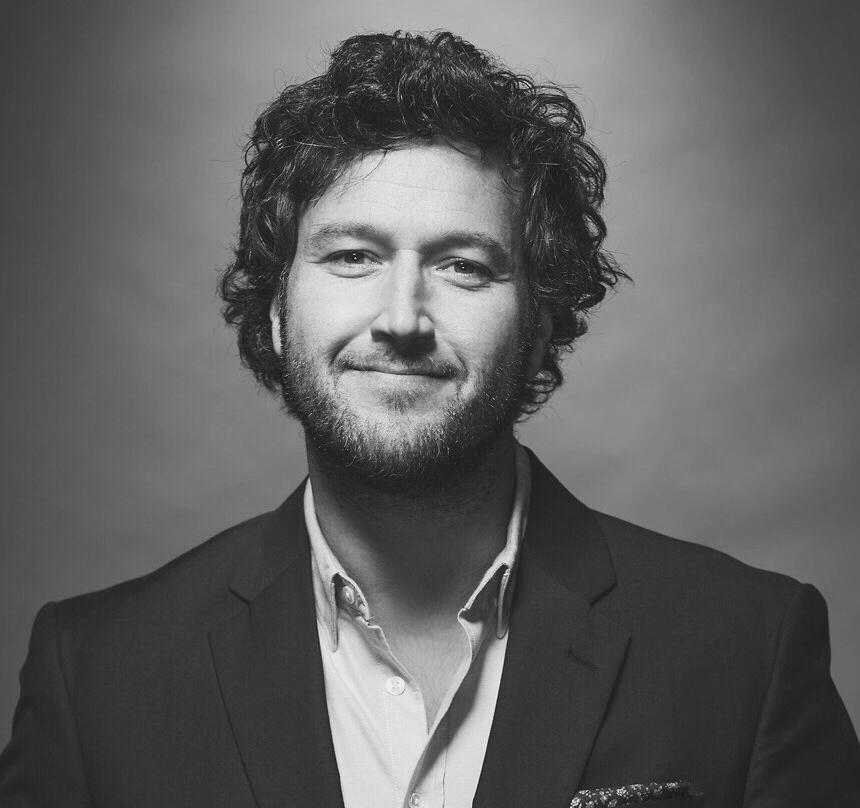
He has a tip for agencies who want to encourage clients to take creative risks. “Just suggest something. Start with something small. The proof is in the pudding, because when you see that creativity going out into the world and the heat it picks up, it becomes contagious. Seeing the results of creativity makes both sides want to do more of it. After the puzzle came out we were already asking ‘OK, but what’s next?’ We’re always looking forward.”
Rethink’s secret sauce
The Heinz campaign was not the only one that impressed the jury – as the fact that Rethink was Agency of the Year attests. Clearly the agency is doing something very right. What’s the agency’s creative process? Does it have a watchword, like “humankind” or “disruption”?
with clients who want what we want, and who buy what we do.” This also enables the agency to have occasionally tough conversations with clients about the relationship. “We can have these conversations because we’re not scared of having a bad fiscal quarter like agencies that report to a holding company. As I said, we’re not chasing revenue. We’re chasing the next big idea.” Given that Rethink beat agencies from all over the world, it occurs to me that there might be a “Canadian style” of advertising that resonates with jurors.
“Canadian agencies have always punched above our weight – and that’s because we’ve never had the same budgets to work with as the US agencies. The idea has to be more powerful: it can’t rely on production quality or star directors.” He adds that Canada is one of the world’s most multicultural countries, which encourages agencies to distil ideas into impactful messages that will appeal to a wide audience. As a result, a lot of Canadian campaigns go global. And since awards juries also tend to be diverse, the same ideas hit them hard too. One of my favourite Rethink wins from last year’s Epica Awards was “The Un-burnable Book” for Penguin Random House. To speak out against the banning of supposedly “unsuitable” books in US schools, the agency created a fire-proof edition of the book The Handmaid’s Tale and asked its author, Margaret Atwood,
Weeks later, I shared this detail during a conversation with Rethink’s global CCO Aaron Starkman and CCO Mike Dubrick. They were grateful for our rigour, but hardly surprised by the outcome. After all, they’d seen the same exercise repeated many times over.
Aaron says: “That’s a good question, because I think there’s a perception that ‘disruption’ or chaos is what fuels creativity. That agencies are all about creatives running around with wacky hair, firing off ideas with no structure and no process. We violently disagree with that notion. We actually think that structure and process is the rocket fuel that creativity needs.”
Rethink’s process, which was established “on day one” and has been evolving over the past 20 years, is called The Rethink Machine. Creative teams are asked to come up with ideas for a given brief on a fast and loose basis – refined “comps” are discouraged. These ideas are then subjected to a peer review process, either internally or with outside partners, based on the acronym CRAFTS.
“Our philosophy here has always been that Heinz is ketchup. But maybe we’re biased, so what would an AI think?”
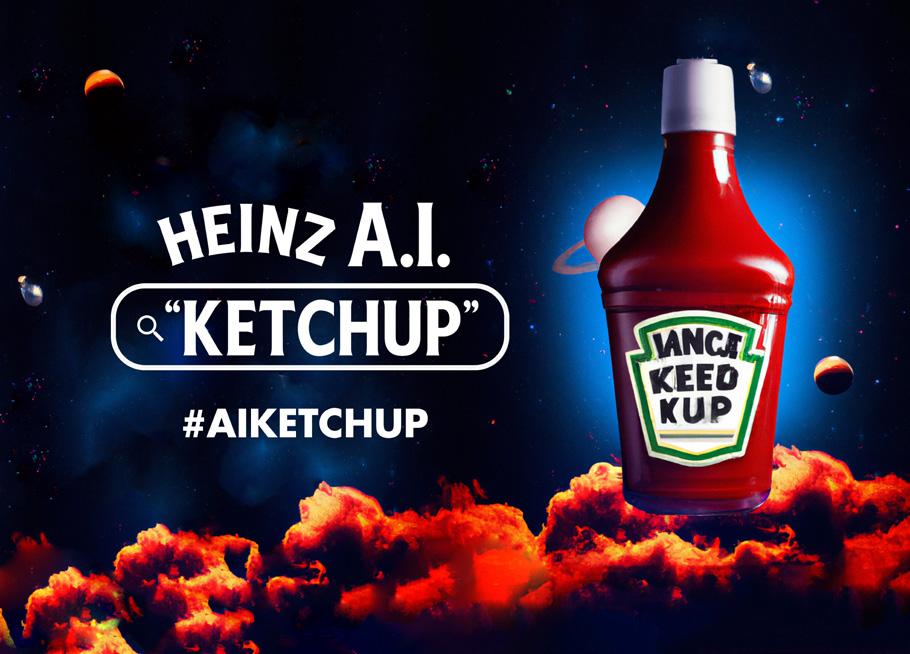
Mike confirms: “We experienced that exact same moment. It started with a hypothesis – and then we had that magical revelation when we typed in the prompt and it yielded Heinz Ketchup-looking bottles.”
The campaign proves that curiosity is one of the many elements that drive creativity. “We’ve always liked the idea of being
In short, the perfect idea is Clear, Relevant, Achievable, Fresh, True and Shareable.
That review results in five to seven remaining ideas that Aaron calls “shallow holes” (“we don’t dig deep at this stage”), which can be taken to the client. Interestingly, given Epica’s jury, the ideas are often presented “in the form of a press headline”. The client chooses the ideas that merit deeper digging, which leads to the eventual unveiling of one or two fleshed-out propositions. “By then there are no surprises, because the client has been
to try and set it alight. With a flamethrower. How on earth did they get her to agree?
Mike Dubrick says: “She was wildly enthusiastic. It was a thrill to have her involved: she’s fierce and inspiring. She got the idea instantly and said, ‘Let’s do it!’ The flamethrower and the book were a little like putting Heinz in AI, in that we took something familiar and put it in a new context that captures attention.” Simple, impactful – and very Rethink.

PAGE NUMBER 5 THE EPICA AWARDS TRIBUNE 2022- 2023 EDITION THE
CREATIVE PRIZE
Aaron Starkman, Global CCO - Rethink
2022 digital grand prix & agency of the year
Mike Dubrick, CCO - Rethink
“Not only are we independent, but we’re never gonna sell”
THE EPICA AWARDS TRIBUNE
THE CREATIVE PRIZE JUDGED BY JOURNALISTS

A new code for rescue workers
road was only three months. The legal requirements for the design of emergency vehicles in Germany are different in each federal state. We decided to test the design in Berlin and Brandenburg, where the design was easily compatible with the legal requirements.
How did you launch the project via the media? I understand that there was an important social media element to the campaign?
The main focus was on Johanniter’s social media channels. There we presented the concept with several videos. Accompanied by interviews and statements from rescue workers and experts such as lawyers. The story was then quickly covered by the traditional media.
What was the initial reaction from the public?
We were overwhelmed by the public reaction. If anything, we had only expected reactions from experts or other rescue organizations. But the discussion, on social media in particular, has shown us that the topic is very emotional for people. We can tell you: as creatives, working in advertising, it’s unusual to get so much positive and emotional feedback. After all it’s not every day that your work even gets applauded by the German chancellor. And, even more importantly, by so many rescue forces that feel supported in their everyday work. So finally it’s not just work from advertisers for advertisers but has real-life impact, which is really nice.
Do you have any figures on how the campaign has positively impacted the work of the emergency services?
If you take the highway fairly regularly, you’ll have noticed the phenomenon of traffic jams caused by motorists slowing down to look at accidents. In some cases, passers-by shoot images with their phones, even leaving their cars to do so. This kind of “rubbernecking” can obstruct emergency workers and aggravate an already perilous situation for accident victims.
Scholz & Friends came up with a solution: a camouflaged QR code on the side of emergency vehicles which, when detected by phones, automatically warns the curious to back off. “Stop! Gawking kills! You are impending rescue workers and are liable to prosecution.”

QR codes have become familiar – but very few of them save lives. The Epica Awards jury felt the innovation merited a hard-fought Responsibility Grand Prix, among many other cause-related projects.
How did the idea first emerge? Were you already working with the client at that point?
RJ & CS: When the idea was born, we as an agency had been working for our client Johanniter (the German first aid and ambulance service) for more than a year and had already completed the corporate design relaunch. In a meeting, we casually learned that onlookers taking photos with smartphones are a big problem for rescue operations.
matically and drops the warning URL. But the problem was: an obvious QR code would have only encouraged people to scan it with their smartphone. The breakthrough was the idea of designing a hidden QR code that doesn’t look like one, more like a camouflage pattern. So that it looks like a design element of the rescue vehicles or uniforms. A QR-Code “in disguise”, that catches people by surprise.
How long did it take to put the operation in place? It must have taken some time to apply the markings to the emergency vehicles?
The time span between the first presentation of the idea to the client and the first prototype ambulance vehicle on the
Right now the design is in a scientific test phase. We expect the final results this fall – but the first interim results look very promising. If the effectiveness of the concept is confirmed, it will be used on all Johanniter rescue vehicles in the future.
What are the prospects for a European or even international roll-out of this service?
Once the effectiveness is scientifically proven, Johanniter is open to sharing the design with other rescue organizations. There is already interest from rescue organizations in Europe, but also from the USA or Dubai. Seeing rescue vehicles with the QR-design in other countries would make us very happy and proud.
It was clear to us that another educational campaign simply wouldn’t do the job. So the real creative challenge was to find a clever technique, how to catch onlookers in the very moment of their wrong-doing.
We thought about QR codes very soon. The beauty of this technique is that the onlookers’ camera recognizes the QR code auto-
PAGE NUMBER 6 2022- 2023 EDITION
To prevent onlookers from getting in the way of rescue workers at emergency sites, Scholz & Friends created a new kind of highway code. Creative directors Ramona Junggeburth and Christoph Schlossnikel tell us how it came about.
Ramona Junggeburth and Christoph Schlossnikel, Creative Directors on the Anti Gawking Awareness Campaign
2022 digital grand prix & agency of the year
“The real creative challenge was to find a clever technique, how to catch onlookers in the very moment of their wrong-doing.”
THE EPICA AWARDS TRIBUNE
THE CREATIVE PRIZE JUDGED BY JOURNALISTS
This book was their baby
A young quartet from Norway’s TRY reveal the hard work that went into encouraging new parents to name babies after IKEA furniture.
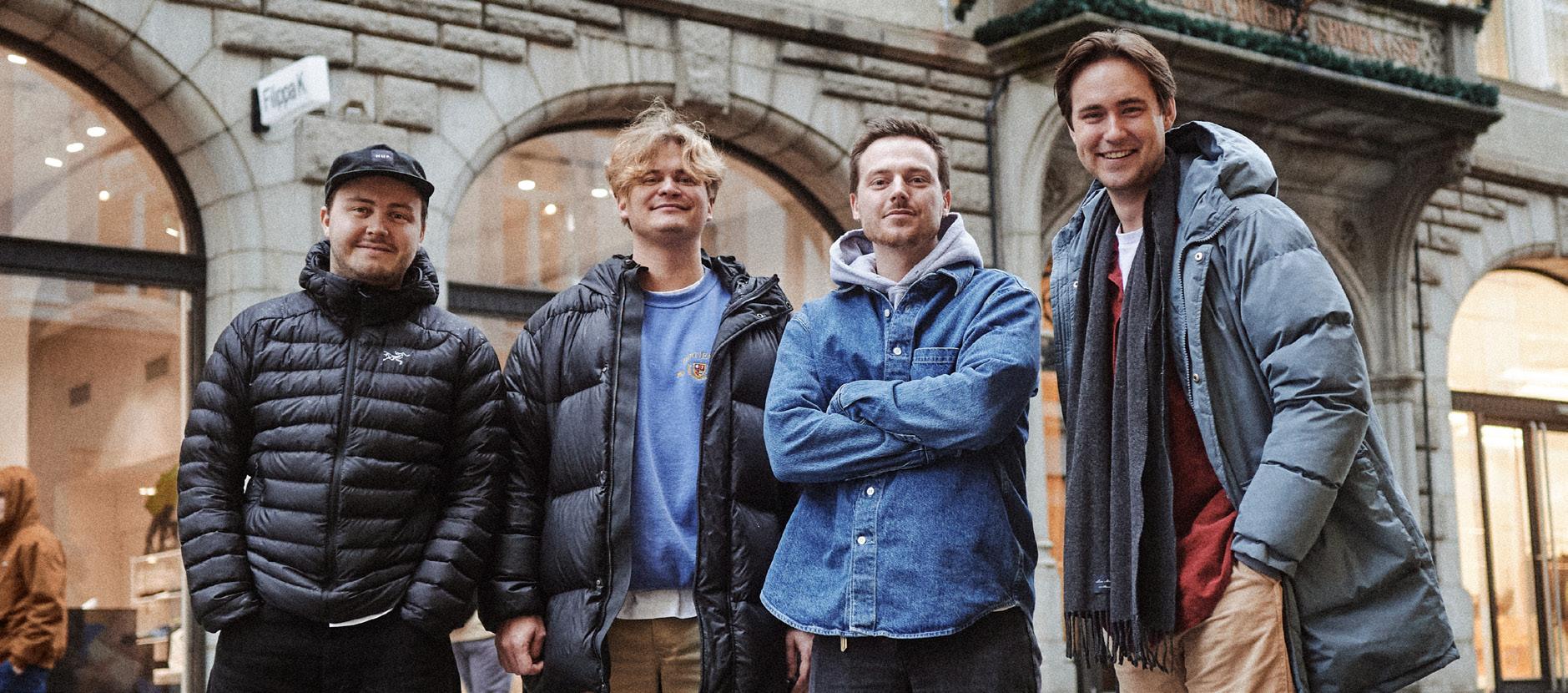
The creative team behind “The Name Catalogue” by IKEA happily admit that they’re among the youngest at renowned Norwegian agency TRY (which is pronounced “tree”, by the way). “We don’t have kids yet – but we knew from family and friends who are parents that choosing baby names can be a challenge,” says copywriter Torkel Skjolden. Still, producing a catalogue full of names of IKEA furniture and proposing it as a source of inspiration to new parents seems like a bit of a leap. In fact, everyone loved the notion – especially the media. But let’s go back to the campaign’s…erm…birth. Imagine the creative quartet (Torkel along with art director Marcus Hassel, copywriter Hallvard Vaaland and art director Mathias Sandvik) batting around ideas after a long working day. “It all started during Covid, when the media here in Norway were talking about a baby boom,” Torkel says. “We felt it was positive news – so we wanted to create something positive from that insight,” Torkel says. “On the other hand, at that time our client IKEA had some supply issues – so for once they couldn’t talk about new products, because they didn’t have any.
Art director Marcus confirms: “An idea like this takes a lot of labour, but we believed in it, and so did the client and our bosses, so we were driven to complete it. We had to give a bit more – and in the end it was worth it.”
Despite their faith in the idea, they weren’t anticipating the “overwhelmingly good” response to it. IKEA’s PR team distributed a press release about the project and it very quickly sparked interest.
When the story was picked up by a magazine in Denmark, says Marcus, the team thought: “Denmark! It’s gone global!” After that the news made it to Germany, creating even more jubilation. “Especially since the catalogue is in Norwegian, so it wasn’t rigged for global exposure.”
Even a journalist in New Zealand mentioned the catalogue. “But the real bucket list moment was The Late Show with Stephen Colbert,” says Torkel. “I was in a store when Marcus called me
that easy to manage? “Not at all,” says Mathias. “The idea felt perfect because there are always old magazines in waiting rooms, so we thought the IKEA Name Catalogue would be perfect for upcoming parents to look through for a change. But the public facilities all told us that they didn’t allow commercial brands into their spaces.”
Contacting private facilities proved difficult too, so in the end there was only one thing for it – the team visited them on foot asking kind receptionists if they could slip the magazine into waiting rooms. “Luckily quite a few of them liked the idea and thought it was funny, so they agreed.”
It’s impossible to determine exactly how many babies have since been named after IKEA items. They’re by no means odd or unpronounceable – Henry, Lena and Vanessa are on the list –and at least one couple have admitted naming their son “Tim” after a 1960 trolley table.
“We’ve certainly seen from the comments sections on social
We thought this idea might give them something to tell their customers about.”
Having worked with the Swedish brand for some time, they knew it had a rich heritage – and that it used “human” names for some of its furniture. “It was like a jigsaw puzzle where all the pieces seemed to fit perfectly.”
IKEA loved the idea, but had no idea how many potential baby names it had used since the beginning (the company was founded in 1943 and produced its first catalogue in 1950). “They said that if we could find more than 50 names, we should go for it.” The team had to trawl through more than 70 years of catalogues manually, as the archive is digitised but not searchable. In the end they unearthed more than 800 names – and wrote all the descriptions for the resulting book themselves. “We didn’t use an AI or anything!” insists Torkel’s fellow copywriter, Hallvard, sounding faintly (but humorously) aggrieved by the question. He adds that the art directors also had to pitch in with the writing.
As you can imagine, this process took some time. “There were long nights,” remarks Hallvard. “We actually stopped counting the hours we worked, otherwise it would have cost the client too much.”
about it. I just said, ‘What?!’”
Mathias adds: “What’s interesting is that the Norwegian press aren’t very keen on covering advertising, so we didn’t get much media coverage here in Norway at the beginning. But then they started writing about the Norwegian ad that had been on The Late Show.”
A radio show even devoted an entire slot to a piece about baby names – inspired by the catalogue.
One of the smartest tactics of the launch campaign was to sneak the catalogue into the waiting rooms of medical facilities. Was
media that parents have found it helpful,” says Torkel (whose name is also in the book). “Many of them have thanked IKEA for the inspiration, so we hope that we’ve helped to name many babies.”
People have also had a lot of fun looking for their own names in the catalogue. In fact, its impact might be far reaching. Twenty years into the future, one of the creative team might mention in passing that they worked on the campaign – and the younger person they’re addressing might reply: “Is that so? Thanks to you, I was named after a wardrobe.”

PAGE NUMBER 7
2022- 2023 EDITION
TRY’s “The Name Catalogue” creative team
v
“It
was
like a jigsaw puzzle where all the pieces seemed to fit perfectly.”
v One of the smartest tactics of the launch campaign was to sneak the catalogue into the waiting rooms of medical facilities.
2022 PR Grand prix
THE EPICA AWARDS TRIBUNE
THE CREATIVE PRIZE JUDGED BY JOURNALISTS
2022 GOLD WINNERS
GRAND PRIX
• FILM: “The spider and the window” by Leo Burnett Germany for Samsung Electronics
• MEDIA: “The Pirate Match” by Mirum Agency (Brazil) for DirectvGo
• INNOVATION: “Touch Card” by McCann New York for Mastercard

• PR: “The Name Catalogue” by TRY (Norway) for Ikea
• PR: “The Missing Chapter” by Leo Burnett India for Procter & Gamble
• DIGITAL: “Ketchup A.I” by Rethink (Canada) for Kraft Heinz
• RESPONSIBILITY: “Anti Look – the life-saving QR design” by Scholz & Friends for Johanniter-Unfall-Hilfe

network of the year
McCann Worldgroup with one Grand Prix, seven Golds, eleven Silvers and ten Bronzes
Top networks:
1. McCann Worldgroup

2. Publicis
3. Wunderman Thompson
AGENCY OF THE YEAR
Rethink with one Grand Prix, two Golds, eight Silvers and four Bronzes
Top agencies:
1. Rethink
2. Try
3. Scholz & Friends
Leo Burnett
Leo Burnett Germany
Leo Burnett Germany
Leo Burnett India
M.NSTR. PARIS
McCann New York
McCann New York
Mirum Agency
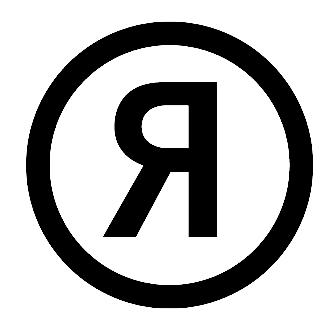
Morgenstern AS
MRM Santiago
MRM Worldwide Spain
neverland creative ltd
Nord DDB Stockholm AB
Performance Art
Rethink
Rethink
Riff Raff Films
Riff Raff Films
Ruf Lanz, Zurich
Ruf Lanz, Zurich
Scholz & Friends
Scholz & Friends
Scholz & Friends
from a legend"
"Top5 Travel" campaign
"The spider and the window"
"The spider and the window"
"The Missing Chapter"
"Guerlain Reaverse"
"Touch Card"
"Touch Card"
"The Pirate Match"
"Finn + Munch"
"Fly Over Cyber Monday"
"#ToyStrike"
"Neighbours"
"The Golden Number"
"The Black Elevation Map"
"Vintage Drip"
"Ketchup A.I"
"Open Spaces"
"Open Spaces"
"When art has to move" campaign
"Animal Handprints" campaign
"Anti Look – the life-saving QR design"
"Anti Look – the life-saving QR design"
"Anti Look – the life-saving QR design"
Retail Services
Recreation & Leisure
Personal Electronics & Devices
Online & Viral Films
Health & Beauty
Metaverse
Financial Services
Experiential & Shopper
Online & Mobile services
Topical & Real-time
Creative Use of Data
Public Interest - Gender Equity
Humour
Restaurants, Bars & Cafés
Websites
Food
Creative Use of A.I.
Luxury & Premium Brands
Direction & Cinematography
Print Craft
Illustration
Jumbo Supermarkets
Top5
Samsung Electronics GmbH
Samsung Electronics GmbH
Procter & Gamble
LVMH
Mastercard
Mastercard
DirectvGo
Finn.no
LATAM Airlines
Ministry of Consumer Affairs
what3words
McDonald's
Black & Abroad
Kraft Heinz
Kraft Heinz
Burberry
Burberry
Welti-Furrer Fine Art Transport
Foundation «Tier im Recht»
Communication & Public Services Johanniter-Unfall-Hilfe
Media Innovation - Traditional Media Johanniter-Unfall-Hilfe
Media Innovation - Alternative Media Johanniter-Unfall-Hilfe
PAGE NUMBER 8 2022- 2023 EDITION
the full results on the Epica Awards website Agency Title Category Advertiser Accenture Song Germany "Growling Creatures" Best Use of Music Krombacher BBDO India "See Equal #Share The Load" Household Maintenance Procter & Gamble India Bickerstaff.658 "We Instead of Us" Non-Alcoholic Drinks Galychyna Commonwealth // McCann "Holiday Ride" Automotive General Motors Dentsu Creative "My 2020 Travel Project" Transport & Tourism Air France/KLM Dentsu Creative "My 2020 Travel Project" Corporate Image Air France/KLM DonerNorth "The Donated Commercial" Radio Advertising Canada’s Organ & Tissue Donation Community FCB Lisbon "Portuguese (Re)Constitution" Publication Design Penguin Random House Portugal Havas Germany / Havas NY "Staybl" Creative Technology Deutsche Parkinson Vereinigung e.V. Havas Germany / Havas NY "Staybl" Mobile Campaigns Deutsche Parkinson Vereinigung e.V. HEREZIE "Dubbing Factory" Social Networks Prime Video Impact BBDO "The Elections Edition" Media An Nahar Newspaper LDV United "Bricks
Find
THE EPICA AWARDS TRIBUNE
THE
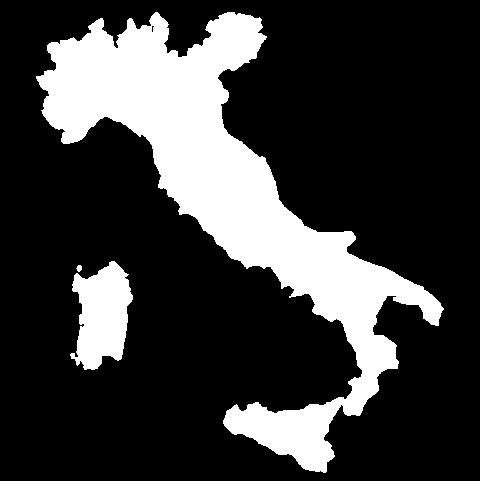
Serviceplan Germany

SOLDATS FILMS
TBWA\HAKUHODO Inc.
TBWA\Media Arts Lab
The 6th
The Mill
The Mill
The Potlatch
TRY
TRY
Turner Duckworth
TV 2 CREATIVE
TV 2 CREATIVE
VIRTUE WORLDWIDE
Weber Shandwick
Wunderman Thompson Lima
Wunderman Thompson Lima
Wunderman Thompson Minneapolis
Wunderman Thompson Paris

PRIZE JUDGED BY JOURNALISTS
Wish"
"Dot Go. The first object interaction app for the visually impaired."
"Outlaw Runners"
"Intoxicating Sounds Posters" campaign
"Start Up - 45 Years of Apple Sounds"
"When in the woods"
"Open Spaces"
"Playtime is over"
"A Night on Earth in Scotland"
"The Proud Forecast"
"The Name Catalogue"
"Maker’s Mark Visual Identity"
"The Copenhagen Bench"
"The Copenhagen Bench"
"Backup Ukraine"
"The Heinicke Deal"
"The Friendly Break Up Collection"
"The Friendly Break Up Collection"
"Speaking in Color"
"The Safety Squad"
2022 GEO FOCUS
A close-up look at which agencies came out on top last season in their respective regions.
Copywriting & Storytelling
Apps & Games
Sports-related Advertising
Advertising Photography
PENNY
Dot Incorporation
Distance
Japan Philharmonic Orchestra
Best Use of Sound Apple
Packaging Design
Post Production & Visual Effects
Oasyhotel
Burberry
Animation Samsung
Graphic Design
Product & Brand Integration
Public Relations
Brand identity
Public Interest - Environment
Integrated Campaigns
Metaverse
Alcoholic Drinks
Homes, Furnishings & Appliances
Product Design
Professional Products & Services
Direct Marketing
UNITED STATES

The Macallan
TV 2
IKEA
Maker's Mark
TV 2 Denmark
TV 2 Denmark
Polycam & UNESCO
A-B InBev
Fontenla
Fontenla
Sherwin-Williams Coil Coating
Newell Brands
UNITED KINGDOM


MIDDLE EAST
CENTRAL AND EASTERN EUROPE


LATIN AMERICA

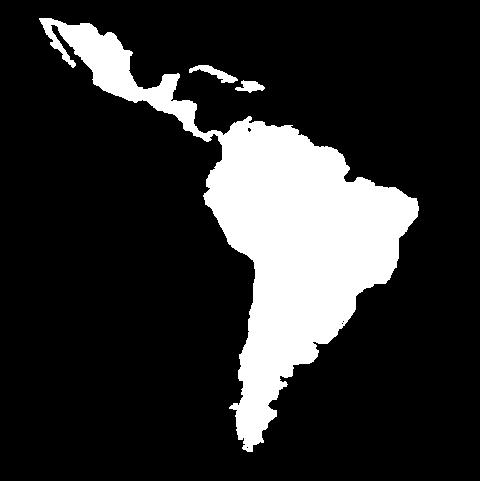

SCANDINAVIA

ASIA PACIFIC
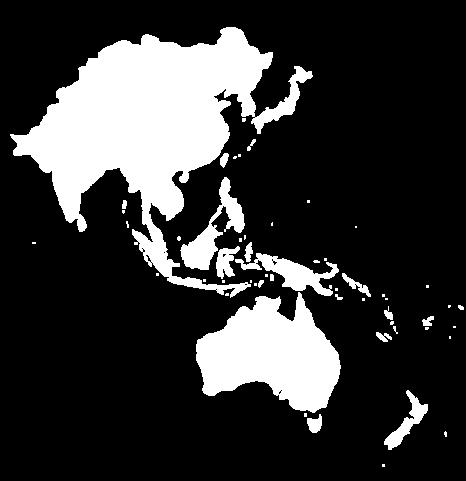
PAGE NUMBER 9
2022- 2023 EDITION
CREATIVE
1. Riff Raff Films
The Mill
McCann London
Top winners:
2.
3.
Top winners: 1. McCann NY 2. Commonwealth // McCann 3. Wunderman Thompson Minneapolis FRANCE Top winners: 1. Dentsu Creative 2. HEREZIE 3. M.NSTR. Paris
1. Scholz & Friends
Leo Burnett Germany
Jung von Matt AG
Germany Top winners:
2.
3.
Top winners: 1. TRY 2. TV 2 CREATIVE 3. Morgenstern AS CANADA Top winners: 1. Rethink 2. DonerNorth 3. Leo Burnett
Top winners: 1. Leo Burnett India 2. TBWA\HAKUHODO Inc. 3. BBDO India
Top winners: 1. Mirum Agency
Wunderman Thompson Peru 3. MRM Santiago
2.
Top winners: 1. Impact BBDO 2. Advantage Marketing & Advertising 3. Keko FZ-LLC
winners: 1. Bickerstaff.658 2. VMLY&R Romania 3. Effectivity s.r.o. Agency Title Category Advertiser Serviceplan Germany "The
Top
NETHERLANDS
Top winners: 1. Media Monks
2. Wieden+Kennedy
3. Dawn | 180 Amsterdam
BELGIUM
Top winners:
1. Wunderman Thompson
2. LDV United
3. Publicis Groupe Belgium
ITALY
Top winners:
1. Armando Testa
2. The 6th
3. AKQA srl | DDB
THE EPICA AWARDS TRIBUNE



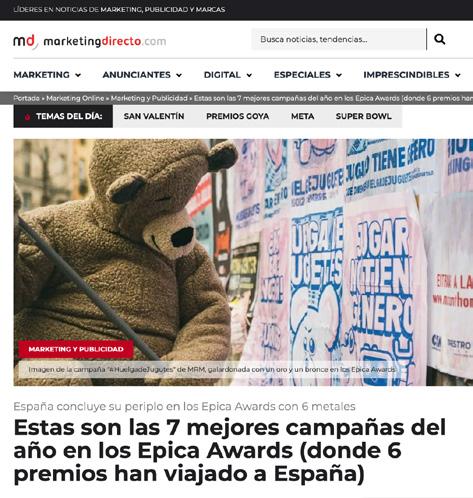

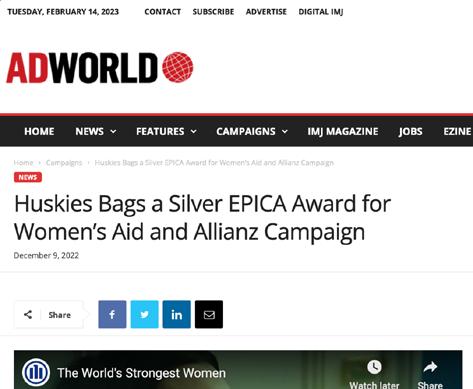


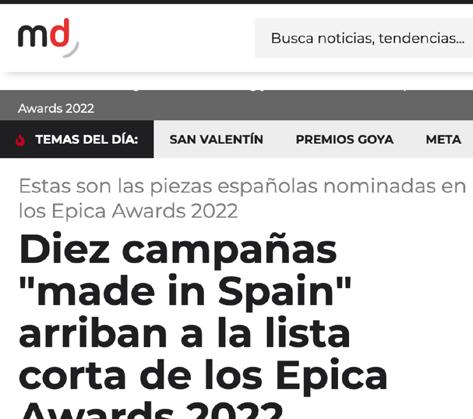

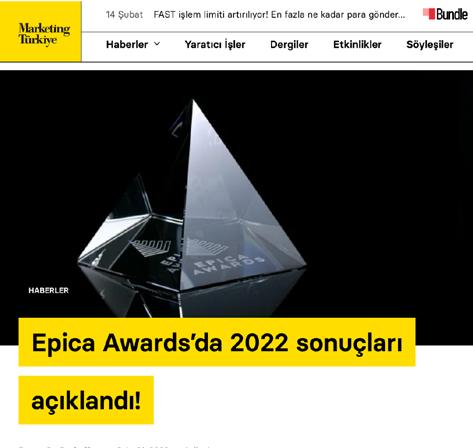
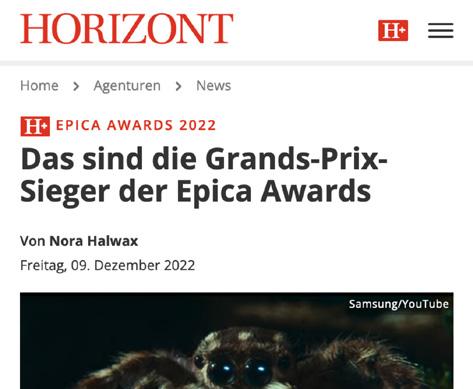

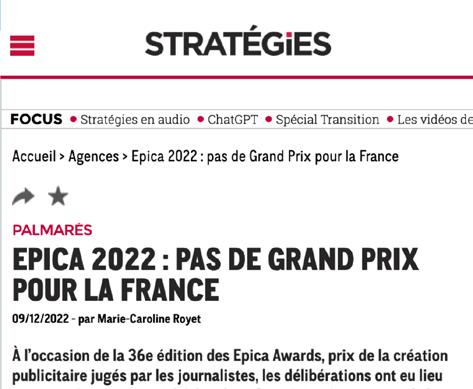




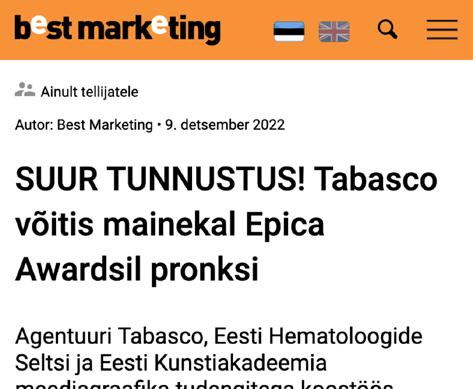
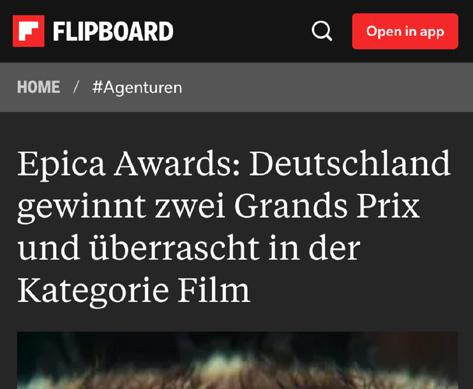
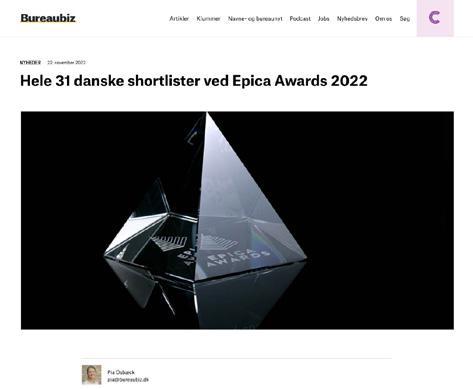


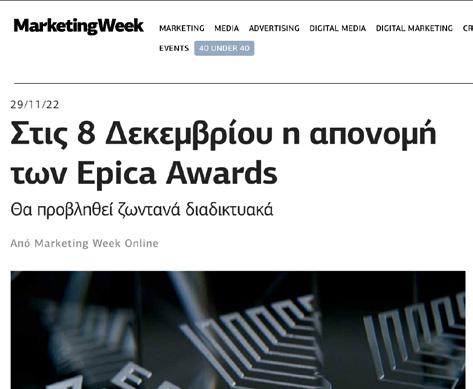

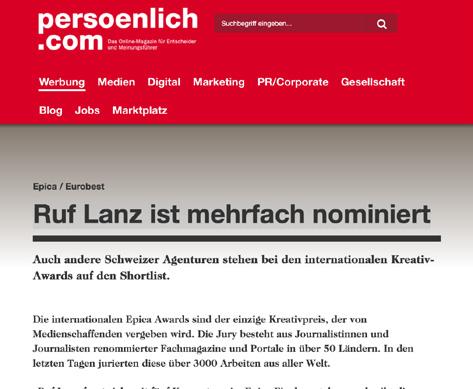
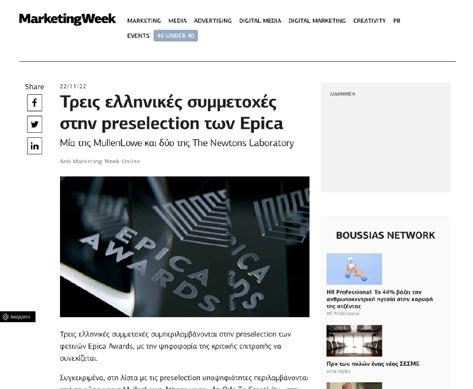




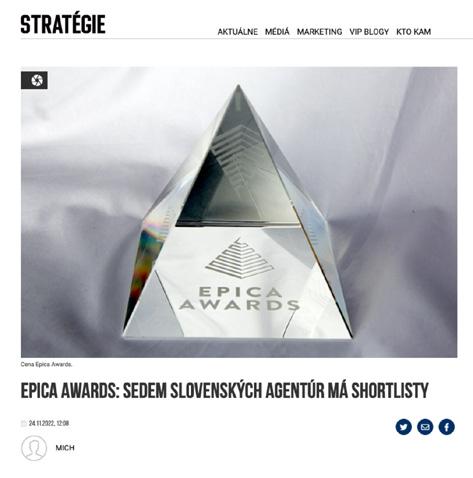



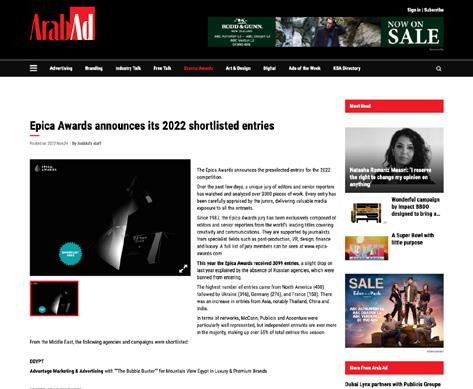



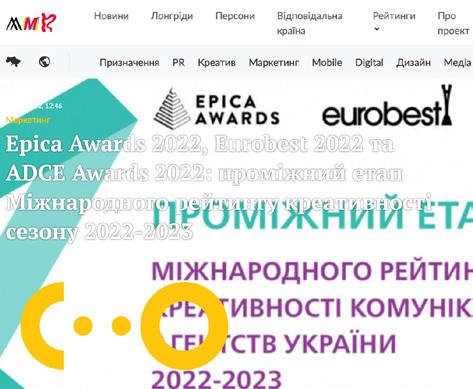
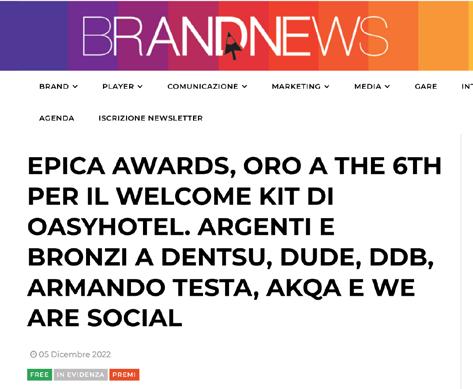


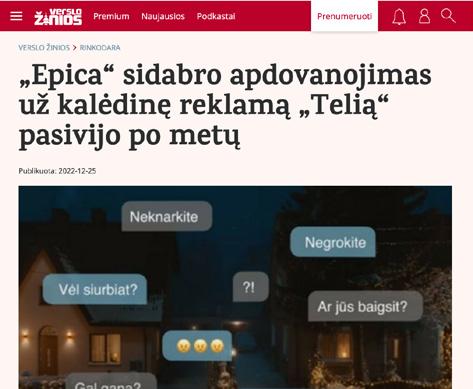

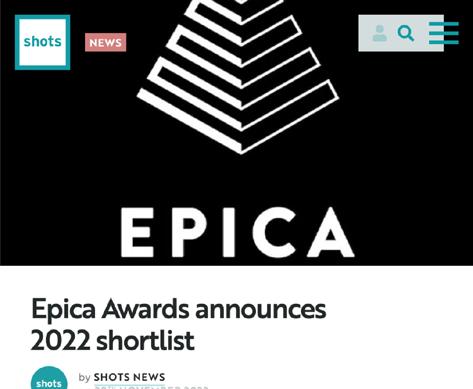
THE CREATIVE PRIZE JUDGED BY JOURNALISTS



“It means so much to receive this recognition, especially from such an esteemed jury of the industry’s most informed and brilliant journalists.
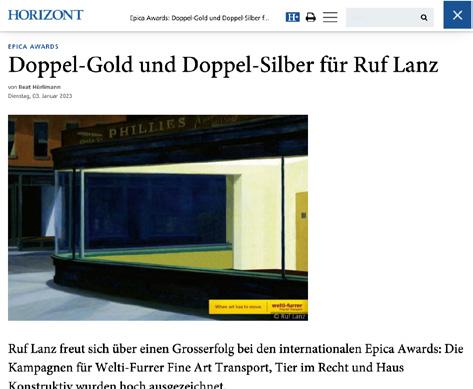


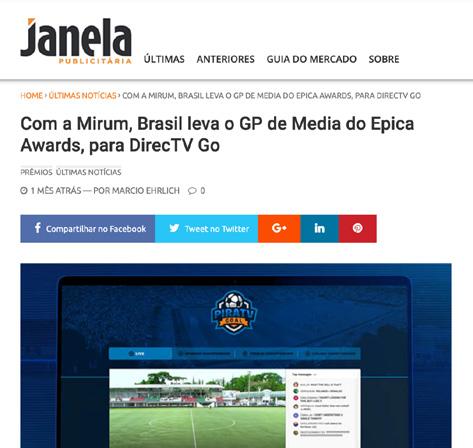


“It is journalism that ensures that the stories behind groundbreaking creative ideas are shared publicly.”



“Epica for me has been career-changing, even life-changing.”


PAGE NUMBER 10 2022- 2023 EDITION
David Griner, Co-founder of the Creative Ladder
Within the agency and the network the creatives always celebrate an Epica Award because you get honoured by the press, by journalists who really dig into stories. Benjamin Merkel, ECD of Leo Burnett Germany
Kate Stanners, Chairwoman and Global Chief Creative Officer of Saatchi & Saatchi
Chaka Sobhani, Global Chief Creative Officer, Leo Burnett Worldwide
THE EPICA AWARDS TRIBUNE
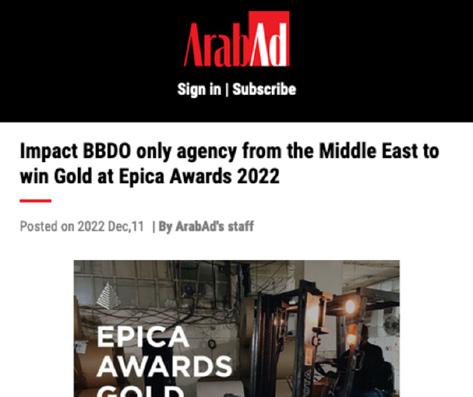

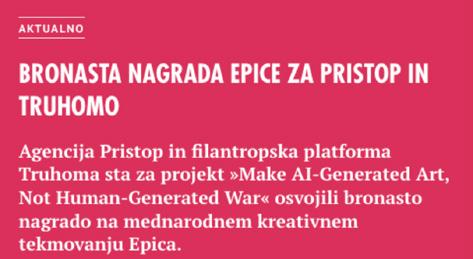



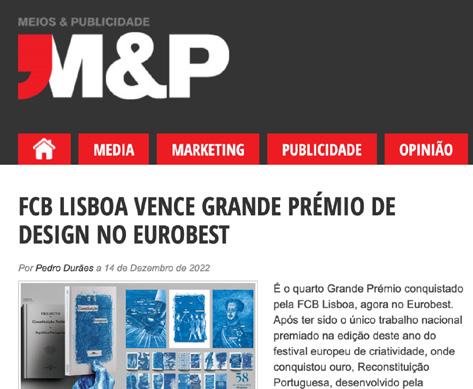
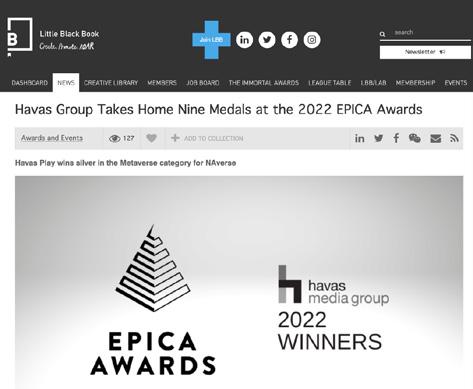

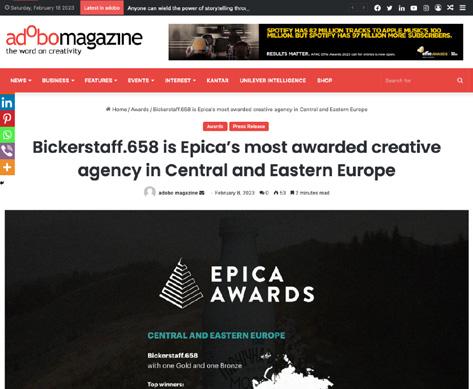




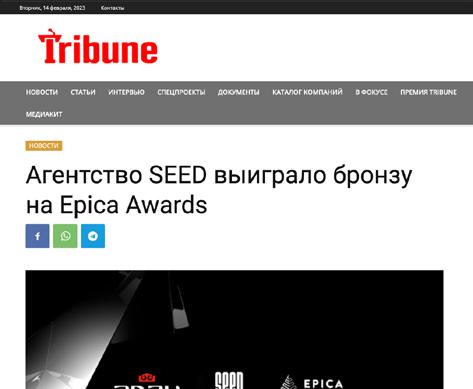


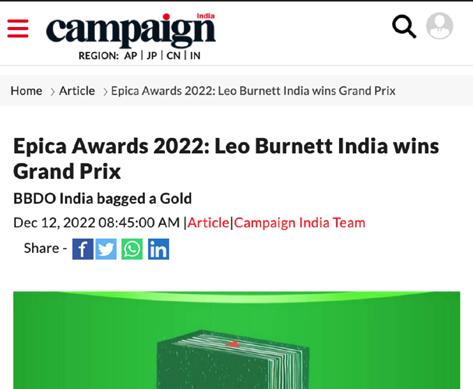
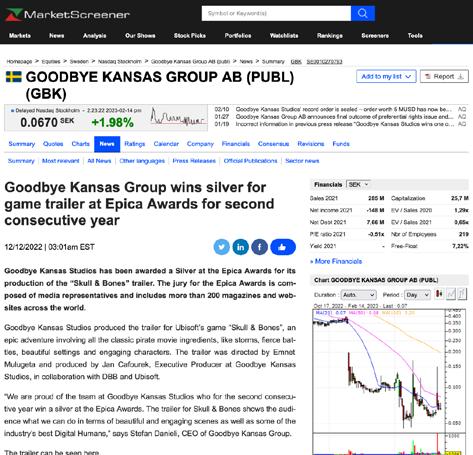
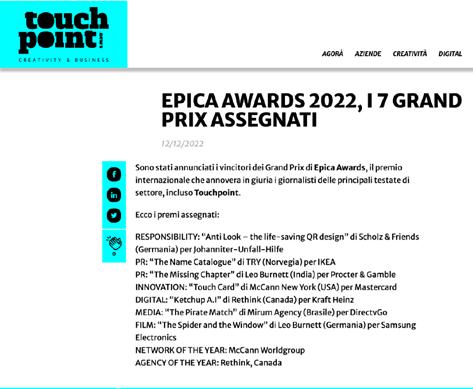
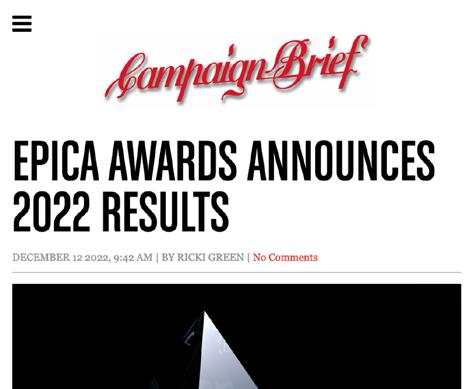
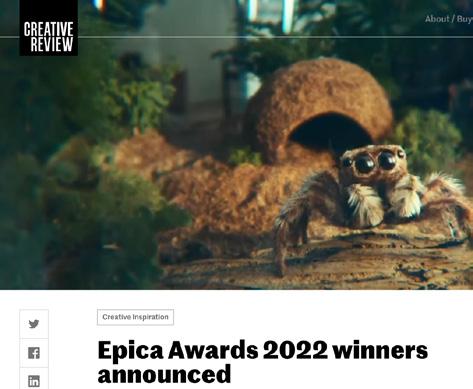


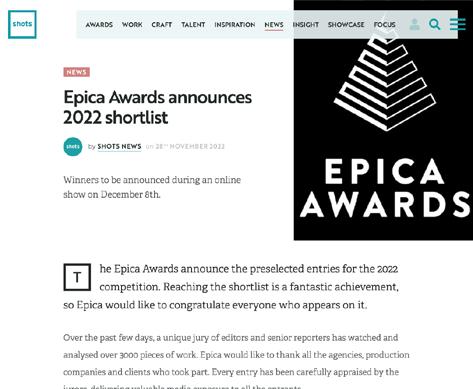
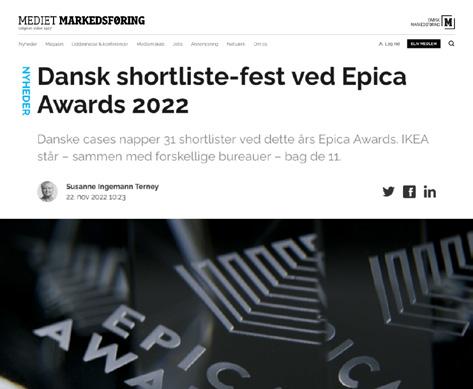




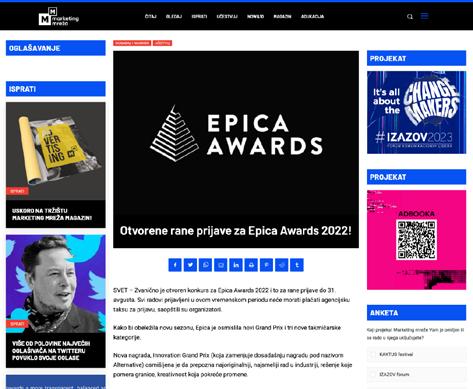



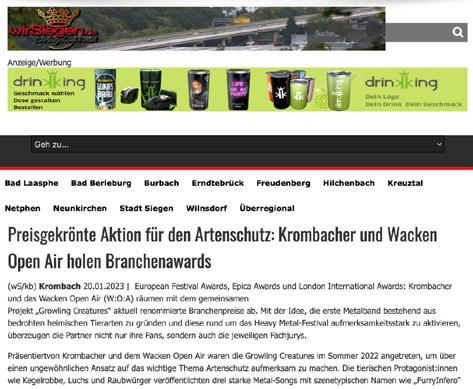
THE CREATIVE PRIZE JUDGED BY JOURNALISTS



“There is no show where your work will be more thoroughly investigated by a more unbiased and more influential audience.”
“Recognition from the Epica jury is particularly meaningful because validation from journalists is critical to the network.”





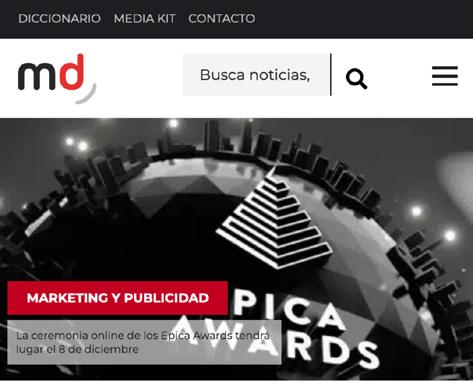


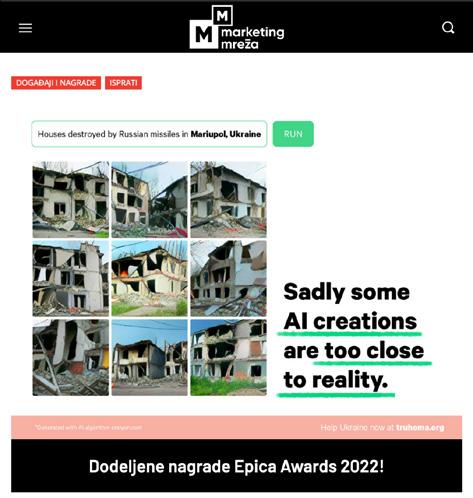
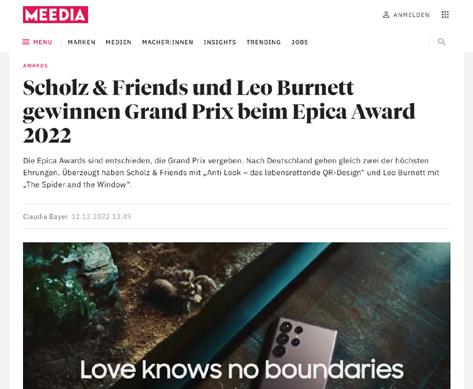

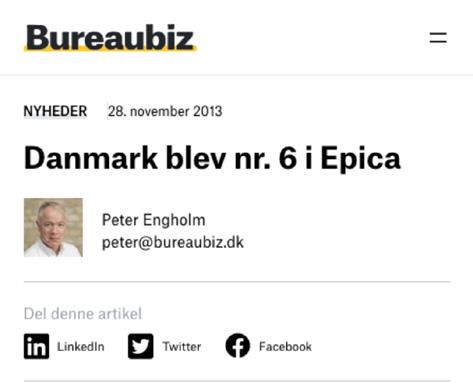

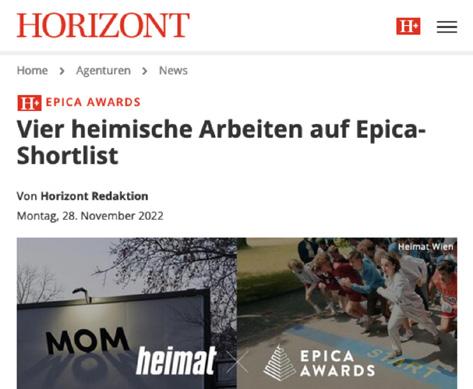



“This selection was not made by creatives and ad people. It was made by journalists. Experienced journalists with their own point of view about what’s relevant, what’s strong, what’s famous.”



 Stephan Vogel, Chief Creative Officer, Ogilvy EMEA
Stephan Vogel, Chief Creative Officer, Ogilvy EMEA

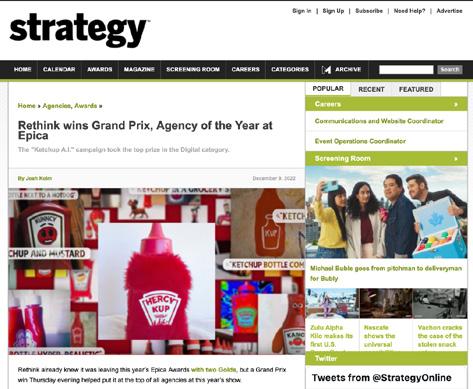
PAGE NUMBER 11
2022- 2023 EDITION
Tor Myhren, VP marketing Communications, Apple
“A journalistic point of view gives us an outside perspective and almost brings the voice of the people into the conversations.”
Piyush
Pandey, Chief Creative Officer Worldwide, Ogilvy
Adrian Botan, Chief Creative Officer Europe,
McCann Worldgroup
2023 KEY DATES
A time to embrace humanity
An AI may have featured in one of our Grand Prix winning campaigns, but the overall approach was distinctly human.
At the end of last year, it felt as if at least one storm had passed. Hardly any of the campaigns that were entered for The Epica Awards referred directly to the pandemic. The Transport & Tourism category showed a few lingering effects, but mostly it was back to its ebullient self.


Having said that, who knows what impact all those lockdowns had on our creative psyches? It’s notable that the wonderful Film Grand Prix winner – “The Spider and the Window”, from Leo Burnett Germany, for Samsung – takes place inside a home, from which our lovelorn arachnid peers longingly out. Stories spring from experiences, after all.
Noteworthy too that the PR Grand Prix – TRY’s “Name Catalogue”, for IKEA – was sparked by the fact that there was a baby boom in Norway after the big shut-in. Historic events have a ripple effect.
Of course, in 2022 there were still some very dark clouds overhead, the most turbulent being the war in Ukraine. In order to take our own small stand, we chose not to accept Russian entries. Elsewhere, economies were battered by inflation and families struggled to make ends meet.
For the worlds of advertising and design – and indeed brands themselves – this was not the time to abandon their shift towards purpose-driven work, with more projects aimed at supporting and empowering communities.
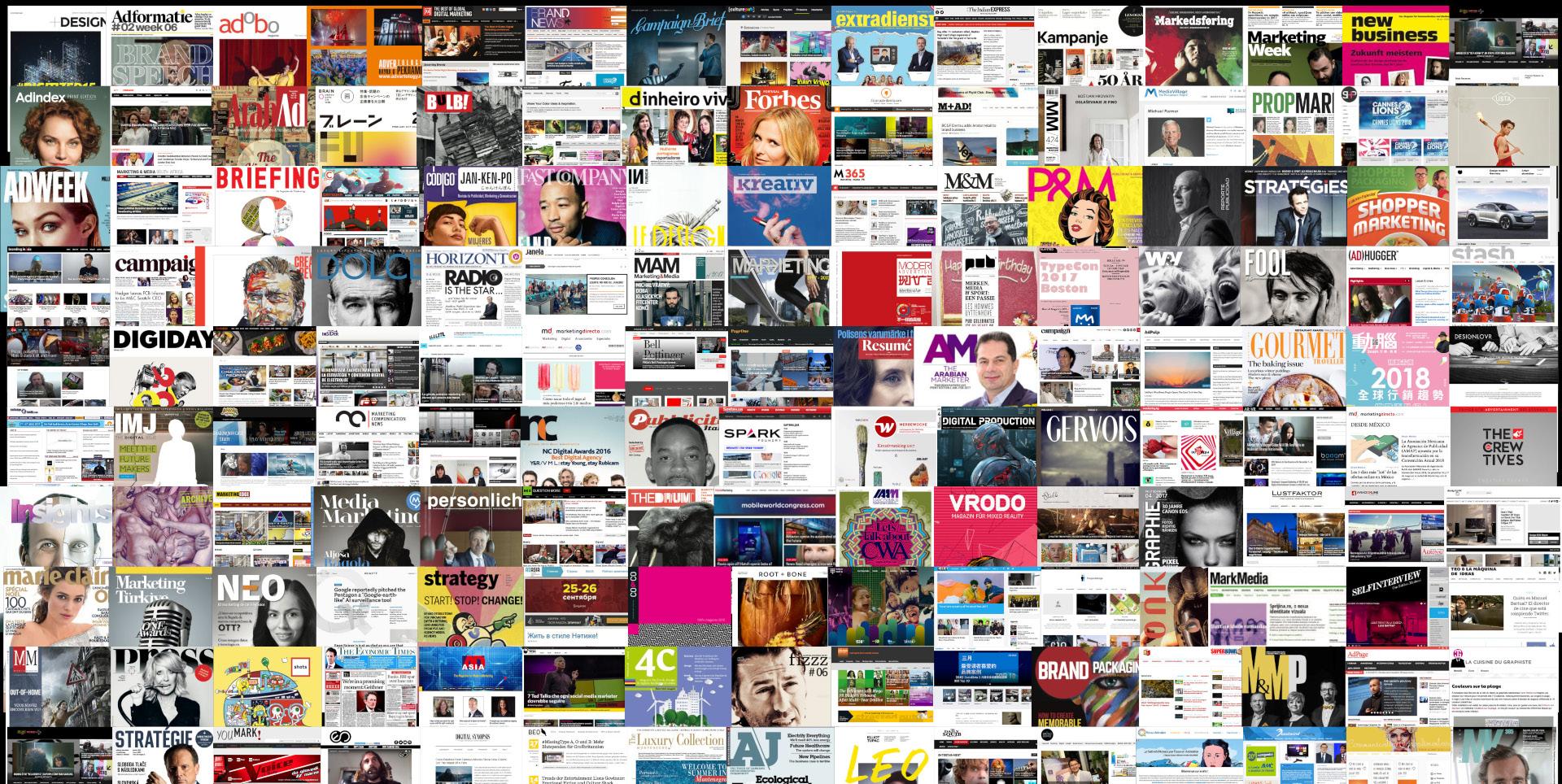

One of the most powerful examples of this was “The Touch Card”, from Mastercard and McCann New York, the winner of our new Innovation Grand Prix. It introduced a simple system of notches that enable blind and partially sighted people to tell their cards apart. Mastercard was arguably one of the first brands to grasp that helping communities and doing business are not mutually exclusive. As Pierre Lipton, McCann New York’s chief creative officer, pointed out, one of Mastercard’s mantras is: “Doing well by doing good.”
In fact, if there was one trend that emerged from the awards last year, it was a warm and generous approach to advertising. The “Pirate Match”, from the Brazilian agency Mirum, the winner of our new Media Grand Prix, did not punish people who illegally streamed football matches – instead it provided them with free (and funny) entertainment. “We work really hard to make things that connect with people or make them laugh,”
confirmed the agency.

During a year when many of us worried about the implications of artificial intelligence, Canada’s Rethink teamed with an AI platform and turned the prompt “ketchup bottle” into a shared creative experiment across social media. “Ketchup AI” won our Digital Grand Prix – but this was technology with a heart. Interestingly, during my interview with Rethink, the agency told me they often present their creative ideas to clients in the form of news headlines. As the Epica Awards are judged by journalists, that immediately struck a chord.
I’ve always been convinced that, as storytellers themselves, journalists have a kinship with creatives. I was recently backed up on this by Benjamin Merkel, ECD Leo Burnett, Germany (the agency behind “Spider”), who told me: “Within the agency and the network the creatives always celebrate an Epica Award because you get honoured by the press, by journalists who really dig into stories.”

Later this year we’ll be back again – still digging your great work.
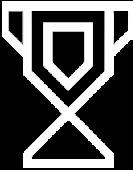

EDITORIAL
MARK TUNGATE mark@epica-awards.com
PLANNING ON ENTERING? HERE’S ALL THE INFO YOU NEED TO ENSURE A SMOOTH ENTRY PROCESS AND TRACK YOUR SUCCESS. EARLY BIRD PERIOD (No registration fee) July 1st to August 31st NORMAL ENTRY PERIOD September 1st to October 6th SHORTLIST PUBLICATION
22nd
7th
Jury includes: +Design (GR) • AdAsia (SG) • adbusiness (GR) • Adformatie (NL) • Adland (US) • Adobo Magazine (PH) • Advertology (RU) • Adweek (US) • AR/VR Magazine (US) • ArabAd (LB) • Best-Marketing (EE) • Bizcommunity (ZA) • Brain (JP) • Brain Taiwan (TW) • Brand Buffet (TH) • Brand News (IT) • Branding in Asia (US) • BrandPackaging (US) • Brief.pl (PL) • Briefing (PT) • Bulb! (CL) • Business Insider (USA) • Campaign (UK) • Campaign Brief (AU) • Campaign India (IN) • Campaign Turkey (TR) • CB News (FR) • CNET (USA) • Código Jan-Ken-Po (PE) • COLOURlovers (IL) • Cominmag (CH) • Communicate (UAE) • Communication Arts (US) • Creative Review (UK) • Culture Pub (FR) • Dagens Media (SE) • Digital Production (DE) • Digital Synopsis (IN) • elmaaltshift (TR) • Entrepreneur Magazine (USA) • exchange4media (IN) • Extradienst (AT) • FONK Magazine (NL) • Forbes (USA) • Grenier aux nouvelles (CA) • Horizont (DE) • Horizont Österreich (AT) • Hot Digital (RU) • IAA MarcommPub (IR) • Influencia (FR) • Infopresse (CA) • InformationWeek (USA) • Insider LATAM (AR) • Joe La Pompe (FR) ) • Kampanje (NO) • Kreativ (HU) • Little Big Animation (FR) • LLLLITL (FR) • Lürzer's Int'l Archive (DE) • M+AD! (NZ) • MAM Marketing&Media (CZ) • MarComm News (UK) • Markedsføring (DK) • Marketing Directo (ES) • Marketing Dive (US) • Marketing Magazin (SI) • Marketing Magazine (MY) • Marketing Türkiye (TR) • Marketing Week (GR) • Marketing365 (MK) • MarketingTribune (NL) • Markkinointi & Mainonta (FI) • MarkLives.com (ZA) • Media in Canada (CA) • Media Marketing (BA) • Media Marketing (MM) (BE) • Mediafeed.pl (PL) • MediaVillage.com (US) • Meedia (DE) • Modern Advertising (CN) • Nature Research (USA) • NC Nuova Comunicazione (IT) • NEO (MX) • New Business (DE) • nieuws.nl (NL) • OOH! (DE) • P&M (CO) • Page One (NG) • Persönlich (CH) • PR Week (UK) • Press (PL) • Professional Photo (UK) • Profit (PAK) • Propmark (BR) • PUB (BE) • Resumé (SE) • RT Russia Today (RU) • Rusbase (RU) • Shots (UK) • SHP+ (CN) • Slanted Publishers (DE) • SocialBeta (CN) • Sostav Ukraine (UA) • Stratégie (SK) • Stratégies (FR) • Strategy (CA) • Tarekchemaly.com (LB) • The Holmes Report (US) • The Stable (AU) • TID & tendenser (DK) • Touchpoint (IT) • VR Today Magazine (DK) • Werben & Verkaufen (DE) • Werbewoche (CH) • Worldofad.asia (KZ)
November
CEREMONY December
FINAL RESULTS December 8th





























































































































































 Stephan Vogel, Chief Creative Officer, Ogilvy EMEA
Stephan Vogel, Chief Creative Officer, Ogilvy EMEA









